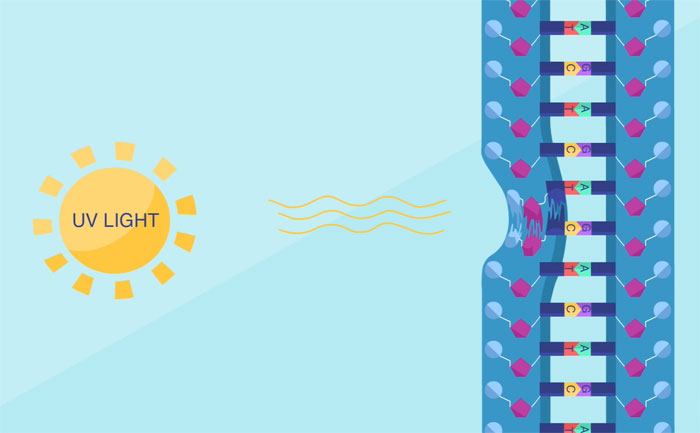What happens when DNA is damaged?
The truth is that the DNA inside one of your cells is destroyed thousands of times a day. Multiply that number by the hundreds of trillions of cells in your body, and we have about 10 to 18 errors in our DNA every day.And because DNA is the template that makes the protein needed for our body's cells to function. will lead to very serious consequences, such as cancer . So how does the body avoid this situation?
There are many types of DNA errors such as the nucleotides that make up damaged DNA; incorrectly matched nucleotides lead to mutation; or the loss of a single or two fragments blocking DNA replication; even upside down parts of DNA. Luckily your cells almost always have a way to deal with these errors. Correction of these errors is due to specific enzymes. Different enzymes will be in charge of fixing various errors.
The most common is a mistake in base pairing . Each Nucleotide has a type of Basal, in the process of doubling DNA, the enzyme DNA polymerase acts to pair nucleotides in accordance with the principle that helps create a new circuit complementing the prototype circuit including Adenine (A) with Thymine (T). , Guanine (G) with Cytosine (X).

There are many types of DNA errors like the nucleotides that make up damaged DNA.
But for every one hundred thousand additions, there will be a mismatch. The enzyme almost immediately recognizes this error and then breaks down the wrong nucleotides and replaces them with the correct ones. In rare cases where these enzymes are not recognized, other proteins will be tested. If the wrong pairing is found, they will remove the wrong nucleotide and replace it. This is called the mismatch repair mechanism.
But DNA can also be damaged after duplication. Many different molecules chemically alter the nucleotides. Part of this is due to environmental factors like cigarette smoke compounds, another part is in cells like Hydrogen Peroxide. Some chemical changes are common, so there will be some specific enzymes to repair the damage.
In summary, at different levels, cells offer different error correction mechanisms . If only one base is broken, it can be repaired with a base cutting mechanism. One basic cutting enzyme is broken, and another will be nearby to find and replace that nucleotide.
The destruction of ultraviolet rays will be more difficult to repair. It sometimes causes two nucleotides to stick together, damaging the double helix structure of DNA. This damage requires a more complex repair process called the nucleotide excision repair mechanism. A group of proteins removes a long section of about 24 nucleotides and replaces them with a whole new one.
Very high frequency radiation such as gamma rays and X-rays damage DNA in a different way. They often break one or both pieces of DNA. Double circuit rupture is the most dangerous form, even causing cell death. There are two most common ways to treat DNA double strand breaks called homologous recombination and dissimilar endpoints.
Homologous recombination uses the undamaged parts of DNA as the prototype circuit. Enzymes mix damaged and non-damaged vessels, causing them to exchange nucleotide sequences and eventually adding them to missing fragments to create two complete double-stranded DNA strands.

Changes in DNA are not always bad.
In contrast, the terminal connection is not homogeneous without the use of a prototype circuit. Instead, a chain of proteins cuts off a few nucleotides and solder the ends off to make them stick together. This process is not very accurate, it can cause genes to mix or move messy. But it would be effective in the absence of other similar DNA.
Naturally, changes in DNA are not always bad. Mutations are beneficial because they help the evolution of organisms. Defects in DNA repair can lead to risks such as premature aging and various types of cancer, so most of us want DNA to be preserved.
- Alcohol damages the DNA molecular chain, leading to cancer
- Observe the DNA repair process in real time
- New skin remedies for severe burns
- American shuttle was damaged after testing
- Tea essence can heal damaged skin due to radiation therapy
- Sichuan earthquake again, thousands of houses damaged
- Unstoppable Copier - 'rescue' emergency data for damaged hard drive
- Hope to restore eyesight
- Breakthrough: Find a 'brain replacement' method to treat neurological diseases
- MP3 Repair Tool - Repair damaged MP3 files
- Telescope 'hunt' aliens damaged after the storm
- Dead Disk Doctor 1.26: Rescue data on damaged disks
- Cell reprogramming
- Use amniotic sac tissue to protect and cultivate damaged cornea
 13 causes of non-itchy rash
13 causes of non-itchy rash How the mouse with human ears changed the world?
How the mouse with human ears changed the world? The truth about 'fried rice syndrome!
The truth about 'fried rice syndrome! What is dental implant?
What is dental implant?